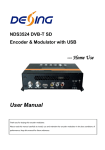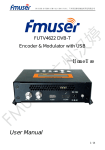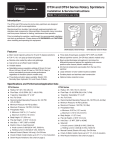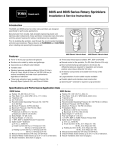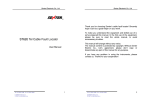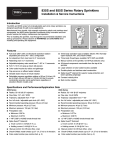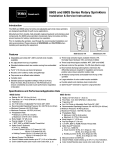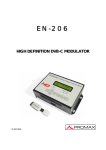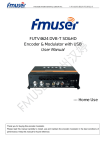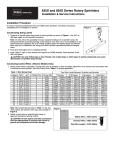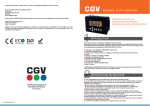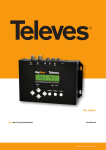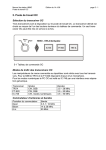Download --- Home Use User Manual
Transcript
SIGNAL-352 Dual Channel SD Encoder & Modulator YPbPr/S-Video/AV to DVB-T Digital RF --- Home Use User Manual Thank you for buying this encoder modulator. Please read this manual carefully to install, use and maintain the encoder modulator in the best conditions of performance. Keep this manual for future reference. Directory CHAPTER 1 Product Introductions .......................................................................... 3 General Description ................................................................................................ 3 Technical Specifications ........................................................................................... 4 CHAPTER 2 Safety Instruction and Installations ...................................................... 5 Safety Instructions................................................................................................... 5 Installations ............................................................................................................. 5 CHAPTER 3 Operations and Management .............................................................. 7 Appendix ............................................................................................................... 13 CHAPTER 1 Product Introductions General Description SIGNAL-352 series encoder & modulator is DIPOL’s consumer electronics which allow audio/video signal input in TV distributions with applications in home entertainment, hotel Digital Signage, shops etc. It is an all-in-one device integrating MPEG2 encoding and DVB-T modulating to convert video/audio signals to DVB-T RF out in the frequency range of 30~960MHz. The signals source could be from satellite receivers, closed-circuit television cameras, Blue-ray players, and antenna etc. Its output signal is to be received by a DVB-T standard TVs or DVB-T STBs and etc. Control Buttons Program Channel 1 DC Power in Program Channel 2 RF in RF out Technical Specifications Encoding Section Encoding MPEG-2 MP@ML(4:2:0) Interface (S-Video/YPbPr/CVBS) *2 Resolution 720x576_50i (PAL); 720x480_60i (NTSC) Bit rate 1.000~19.500 Mbps Encoding MPEG1 Layer II Interface 2*Stereo /mono Sample rate 48KHz Bit rate 64, 96, 128, 192, 256, 320, 384kbps Video Audio Modulator Section Standard DVB-T COFDM Bandwidth 6M, 7M, 8M Constellation QPSK, 16QAM, 64QAM, Code rate 1/2, 2/3, 3/4, 5/6, 7/8. Guard Interval 1/32, 1/16, 1/8, 1/4. Transmission Mode: 2K, 8K MER ≥42dB RF frequency 30~960 MHz, 1KHz step RF output level -16~ -36 dBm (71~91 dbµV), 0.1db step System Management Local control: LCD + control buttons Language English LCN Insertion yes General Power supply DC 12V Dimensions 144*238*52mm Weight < 1kg Operation temperature 0~45℃ CHAPTER 2 Safety Instruction and Installations Safety Instructions WARNING: Hot plug is not allowed since it may cause system halted. To prevent fire or electrical shock, do not expose the device to rain or moisture. The encoder modulator is powered with a voltage of 12V DC. The power supply voltage must not exceed the recommended voltage, which otherwise may cause irreparable damage to the device and the invalidation of the warranty. Therefore: Do not replace power supply with a voltage greater than 12V DC. Do not connect the device to the power if the power cord is damaged. Do not plug the device into mains supply until all cables have been connected correctly. Do not cut the cord. Avoid placing the device next to central heating components and in areas of high humidity. Do not cover the device with elements that obstruct the ventilation slots. If the encoder modulator has been kept in cold conditions for a long time, keep it in a warm room minimum 2 hours before plugging into the mains. Mount the device in vertical position with the connectors located on the top side. When replacement parts are required, be sure the service technician has used replacement parts specified by the manufacturer or have the same characteristics as the original part. Unauthorized substitutes may result in fire, electric shock or other hazards. Safety check- Upon completion of any service or repairs to this device, ask the service technician to perform safety checks to determine that the device is in proper condition. Installations RISK of damage to the unit Mechanically handling the unit may result in damage. Do not connect the unit to the power supply before or during assembly. Connect the unit as below instructed. NO HOT PLUG AND CONNECT THE CABLE AS FOLLOWING STEPS. 1. M Mount and tighten the screws and plugs to secure the unit to the wall. Left 10 cm of free 1 space around from each unit. 2. C Connect the signal input in the respective connectors. 4 The signal source can be from a surveillance monitor, 3 DVD, set-top box, CCTV and etc. 3. Optionally, connect loop-through RF the input coaxial cable. 4. Connect cable to RF output to STB/TV. 5. Power supply connection: a) Connect the earth cable; b) Connect the power plug to the unit mains connector; c) Connect the power plug to the mains socket. Cascade Installation SIGNAL-352 unit has 1 TV signal to RF output encoded as DVB-T Digital TV signal. Several SIGNAL-352 units can be cascaded in order to increase the capacity. The maximum capacity of a series of N units is 1xN incorporated TV signals. To cascade 2 or more units, connect the RF output of the preceding unit to the TV input (loop-through) 5 2 of the next unit (see right illustration). CHAPTER 3 Operations and Management SIGNAL-352 is controlled and managed through the key board and LCD display. LCD Display – It presents the selected menu and the parameter settings. The backlight in the display is on when the power is applied. LED – These lights indicate the working status Power: It lights on when the power supply is connected. Alarm: It lights on when the there is error, such as the signal source loss. Lock: It lights on when the signal source connected and goes off when the signal lose. Left/Right/Up/Down buttons – Use these buttons to turn the screen pages, shift the target items by moving the triangle, or change the parameter settings in the program mode. Enter – Use this button to enter a submenu or save a new setting after adjustment; press it to start adjusting the value of certain items with Up/Down buttons when the corresponding Hue +001 ► Enter ► Hue +001 ► Hue 1 ► underline flash; Hue +002 Press it to activate the hidden selections and change the setting with Up/Down (or Left/ Enter Audio Bit rate *128 Enter Audio Bit rate ►128 ► Audio Bit rate 128 ► Right) buttons. Audio Bit rate ►192 Menu – Press this button to step back Lock – Locking the screen / cancelling the lock state, and entering the main menu after the initialization of the device. After pressing lock key, the system will question the users to save present setting or not. If not, the LCD will display the current configuration state. When the power is connected, the LCD will start to initialize the program. The LCD menu goes as below chart. Initializing DVB-T 506.000MHz 1: 576i 6.93Mbps Main Menu Status Main Menu Encoder Main Menu Modulator Up Down Enter Menu Lock 1 Status Alarm 2 Status Uptime 3 Encoder Program 1 Program 1 Video Video Interface Video In Status Resolution Video Bitrate Rate Mode Aspect Ratio Sharpness Gop Struct Brightness Contrast Saturation Hue 4 Program 1 Audio Audio Audio Bitrate Audio Format 5 Program 1 Program Info Program Info Program Output Program Name Service Name Program Number PMT PID PCR PID Video PID Audio PID LCN EIT Event 6 Encoder Program 2 (“ Program 2” contains same content with “ Program 1” ) Modulator Bandwidth Bandwidth ►8M 7M 6M 7 Modulator Constellation Constellation ►64QAM 8 Modulator FFT FFT ►2K 9 Modulator Guard Interval Guard Interval ►1/32 8K 10 Main Menu TS Config Modulator Code Rate Code Rate ►7/8 11 Modulator RF Frequency RF Frequency 650.000 MHz 12 Modulator RF Level RF Level -10.0 dBm 13 Modulator RF On RF On Off *On 14 Modulator Bit Rate Bit Rate (val/max) 6.986M/31.668M 15 TS Config TSID 16 TS Config ONID 17 TS Config NIT TS Config EIT Main Menu System NIT Network ID Network Name Version Mode Version Number LCN Mode Private Data NIT Insert EIT Language Code EIT Insert 18 19 System Save Config Save Config? Yes ►No 20 System Load Saved CFG Load Saved CFG? Yes ►No 21 System Factory Reset Reset all sets? Yes ►No 22 System LCD Time-out LCD Time-out ►30 s 23 System Key Password Set Password 24 System Lock Keyboard Lock Keyboard Yes ►No 25 System Product ID xxxxxxxxxxxxx xxxxxxxxxxxxx 26 System Version Encoder Modulator SW 1.08 HW 1.1C 27 XXXXXX st 1) DVB-T: modulating standard; XX.XXX MHz: the current output frequency; 1: the 1 program channel; 576i: video resolution of signal source; X.XX Mbps: the current encoding bit rate 2) Alarm Status: For example, if the signals lose, it will give alarm and display error type under this menu. For example: Video 1 Not Lock 3) Uptime: It displays the working time duration of the device. It times upon power on. 4) Video Parameters: User can enter the items respectively to set video parameters. Interface: select a right interface type from the 3 options. The device then can automatically search the signal and starts to encode. Resolution: signal source resolution, read-only. User can also adjust values of rest items (Bit rate: 0.500~19.500 Mbps; Brightness & Contrast & Saturation: 0-255; Hue: -128 - +127) 5) Audio Bit rate: Select audio bit rate among 64, 96, 128, 192, 256, 320, 384 kbps. Audio Format: Select audio format among MPEG2, LC-AAC and HE-AAC. 6) Program Information: User can enable or disable the program output under menu Program Output. User can also enter the other items to edit the Service Name, Program Name, Program Number, and PIDs of PMT, PCR, Video and Audio, and edit LCN (Logical channel number). EIT Event – User can enter this menu to setup EIT (Event Information Table) for the current and next program event. The EIT contains Start Year, Start Time, Duration, and Event Name of the event. All the EIT information can be displayed on the TV screen on condition that the EIT is chosen to insert (see explanation 19.). 7) Bandwidth: choose between 6M, 7M and 8M. 8) Constellation: DVB-T modulator contains 3 constellation modes – 64 QAM, QPSK and 16 QAM. 9) FFT (Transmission Mode): Select between 2K and 8K. 10) Guard Interval: Select among 1/32, 1/16, 1/8 and 1/4. 11) Code Rate: It refers to FEC-Forward Error Correction rate. It contains 1/2, 2/3, 3/4, 5/6 and 7/8. NOTE: The different combination of bandwidth, constellation, guard interval and code rate (FEC) will form a different output code rate. Please refer to appendix table 2. 12) RF Frequency: Adjust it at range of 30 to 999 MHz. Set it according your regional situation or inquire your local services. 13) RF Level: Adjust it at range of -16~ -36dBm. 14) RF On: User can choose to turn on or turn off the RF under this menu. 15) Bit Rate: User can read the current modulating bit rate and the maximum bit rate 16) TSID: (Transport Stream ID) User can view or adjust after enter this menu. 17) ONID: (Original Network ID)-User can view or adjust after enter this menu. 18) NIT: (Network Information Table) NIT table is a very important table for describing the network and TS. User can enter the submenus displayed and edit the values or select the LCN (Logical channel number) mode, and choose whether to insert the NIT. If user chooses to insert the NIT, information (Network ID, Network Name, LCN Mode, Private Data and LCN number of the program mentioned in explanation 6) will be added to the transport stream. NOTE: when the Private Data is set as 0*0, it is invalid. 19) EIT: EIT Insert - As mentioned above (6), the event information table can be chosen whether to insert into the TS or not under this menu. If yes, the EIT information set above (6) will be displayed on the TV screen. Language Code – to set the EIT language For example, code of the English language is eng. If you set the code as eng, the EIT displayed will be in English language. 20) Save Config: Yes/No-to save/give up the adjustment of setting. 21) Load Saved CFG: Yes/No-to load/ not to load the saved configuration. 22) Reset all sets: Yes/No-choose/not choose the factory’s default configuration. 23) LCD Time out: A time limit that LCD will light off. Choose among 5s, 10s, 45s, 60s, 90s and 120s (seconds). 24) Key Password: to set a 6-digit password for unlocking the keyboard. 25) Lock Keyboard: Choose Yes to lock the keyboard, then the keyboard will be locked and cannot be applicable. It is required to input the password to unlock the key board. This operation is one-off. (Password forgotten, please use the universal code “005599”.) 26) Product ID: User can view the serial number of this device. It is read-only and unique 27) Version: It displays the version information of this device. Encoder Modulator: the name of the device; SW: software version number; HW: hardware version number. User can also press ENTER again to view the published time of this device. Appendix Australia Air Channels Ch. Australia Air Channels Frequency Start Center End VHF C00 C01 C02 C03 C04 C05 C5A C06 C07 C08 C09 C9A C10 C11 C12 45 56 63 85 94 101 137 174 181 188 195 202 209 216 223 48.5 59.5 66.5 88.5 97.5 104.5 140.5 177.5 184.5 191.5 198.5 205.5 212.5 219.5 226.5 52 63 70 92 101 108 144 181 188 195 202 209 216 223 230 UHF C20 C21 C22 C23 C24 C25 C26 C27 C28 C29 C30 C31 C32 C33 C34 C35 C36 C37 470 477 484 491 498 505 512 519 526 533 540 547 554 561 568 575 582 589 473.5 480.5 487.5 494.5 501.5 508.5 515.5 522.5 529.5 536.5 543.5 550.5 557.5 564.5 571.5 578.5 585.5 592.5 477 484 491 498 505 512 519 526 533 540 547 554 561 568 575 582 589 596 Ch. Frequency Start Center End C38 596 599.5 603 C39 603 606.5 610 C40 C41 C42 C43 C44 C45 C46 C47 C48 C49 C50 C51 C52 C53 C54 C55 610 617 624 631 638 645 652 659 666 673 680 687 694 701 708 715 613.5 620.5 627.5 634.5 641.5 648.5 655.5 662.5 669.5 676.5 683.5 690.5 697.5 704.5 711.5 718.5 617 624 631 638 645 652 659 666 673 680 687 694 701 708 715 722 C56 722 725.5 729 C57 729 732.5 736 C58 C59 C60 C61 C62 C63 C64 C65 C66 C67 C68 C69 C70 C71 C72 C73 C74 C75 736 743 750 757 764 771 778 785 792 799 806 813 820 827 834 841 848 855 739.5 746.5 753.5 760.5 767.5 774.5 781.5 788.5 795.5 802.5 809.5 816.5 823.5 830.5 837.5 844.5 851.5 858.5 743 750 757 764 771 778 785 792 799 806 813 820 827 834 841 848 855 862 Table 1 Australia Television Frequency/Channels (MHz) Modulation Constellation 1/4 1/2 2/3 QPSK 16QAM 64QAM 6MHz Bandwidth Guard Interval FEC 1/16 1/32 1/4 1/8 1/16 8MHz Bandwidth Guard Interval 1/4 1/8 1/16 1/32 The weak ability of error-correcting and anti-interference in this area 6.03 5.80 6.45 6.83 7.03 6.64 7.37 7.81 6.03 8.04 3/4 1/8 7MHz Bandwidth Guard Interval 1/32 6.22 6.58 6.78 6.53 7.25 7.68 7.91 7.46 8.29 8.78 9.05 5/6 6.22 6.91 7.31 7.54 7.25 8.06 8.53 8.79 8.29 9.22 9.76 10.05 7/8 6.53 7.25 7.68 7.91 7.62 8.46 8.96 9.23 8.71 9.68 10.25 10.56 1/2 2/3 7.46 9.95 8.29 11.05 8.78 11.70 9.04 12.06 8.70 9.67 11.61 12.90 10.24 13.66 10.55 14.07 9.95 13.27 11.06 14.75 11.71 15.61 12.06 16.09 3/4 11.19 12.44 13.17 13.57 13.06 14.51 15.36 15.83 14.93 16.59 17.56 18.10 5/6 12.44 13.82 14.63 15.08 14.51 16.12 17.07 17.59 16.59 18.43 19.52 20.11 7/8 13.06 14.51 15.36 15.83 15.24 16.93 17.93 18.47 17.42 19.35 20.49 21.11 1/2 11.19 12.44 13.17 13.57 13.06 14.51 15.36 15.83 14.93 16.59 17.56 18.10 2/3 14.92 16.58 17.56 18.09 17.41 19.35 20.49 21.11 19.91 22.12 23.42 24.13 3/4 16.79 18.66 19.76 20.35 19.59 21.77 23.05 23.75 22.39 24.88 26.35 27.14 5/6 18.66 20.73 21.95 22.62 21.77 24.19 25.61 26.39 24.88 27.65 29.27 30.16 7/8 19.59 21.77 23.05 23.75 22.86 25.40 26.89 27.71 26.13 29.03 30.74 31.67 Table 2 Recommended MPEG-2 Code Rate















